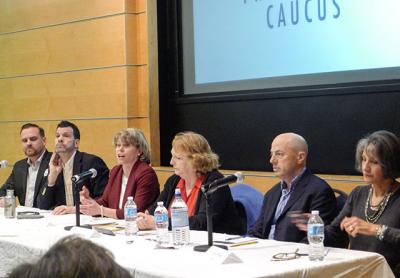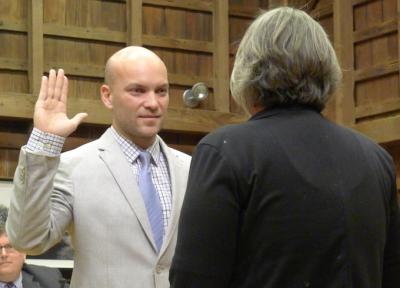First Look at Lee Zeldin's Challengers
First Look at Lee Zeldin's Challengers

Almost an hour passed before Representative Lee Zeldin’s name was uttered at a forum featuring six candidates for the Democratic Party’s nomination to oppose him on Saturday, but once it did, he was roundly criticized as a rubber stamp for President Trump’s policies, particularly with respect to immigration.
The forum, hosted by the Southampton Progressive Caucus, drew an overflow crowd to Chancellors Hall at the State University’s Stony Brook Southampton campus. It also featured an activist fair with groups including the East End Action Network, Indivisible North Fork, Let’s Visit Lee Zeldin, the Long Island Progressive Coalition, Progressive East End Reformers, and the Southampton Town Democratic Committee.
The president’s reported language in reference to Haiti and African nations during a discussion with lawmakers last Thursday on immigration matters was widely criticized. Mr. Zeldin, a second-term Republican representing New York’s First Congressional District, defended the president on CNN and on social media, saying on Twitter that he would not “call for the President’s mouth to be washed out with soap” and reiterating his support for him. A story on Mr. Zeldin’s comments appears elsewhere on this page.
Mr. Trump’s remarks were bad, said Brendon Henry, one of the candidates at Saturday’s forum, but Mr. Zeldin’s were worse. “I actually told him on his web page, ‘This is why I’m going to beat you in November,’ ” he said to applause. “We can’t become a nation that turns its back on people.”
Mr. Henry, who lives in Center Moriches and works as a bartender, said that immigrants are “hard-working people. They’re families, people in your community. . . . I know these people, and all they want is a chance.”
Mr. Trump’s meeting with legislators could have led to a resolution on what to do about the so-called Dreamers — undocumented immigrants brought into the country by their parents — but “Trump shot it down,” said Perry Gershon, a candidate who lives in East Hampton. “And you can look at where Lee Zeldin has come out on this. He’s not attacking Trump. He says we’re not going to wash his mouth out with soap. That’s not the way we fix our problems in America. We need our congressman to be pushing for immigration reform.”
Vivian Viloria-Fisher, a former County Legislator from East Setauket, said that for a time Suffolk County was “ground zero for immigrant issues” and that the county has a history of shameful incidents.
Ms. Viloria-Fisher said that when Mr. Zeldin was campaigning against his predecessor, Tim Bishop, in 2014, he used “immigration as a fearmongering tactic to try to get votes.” Immigrants applying for legal status under the Deferred Action for Childhood Arrivals initiative “have had to put their lives on hold,” she said, and Mr. Trump has pulled the rug out from under “people who have a proven record of being great participants in our county’s culture, in our country’s communities.”
“Lee Zeldin has not done anything to make their lives whole again,” Ms. Viloria-Fisher said. “We must have a comprehensive immigration policy, because we can’t continue to have 12 million people, maybe more, living in the shadows.”
Elaine DiMasi, a former project manager at Brookhaven National Laboratory, also spoke about illegal immigration being used as a political tactic: “Why are we still afraid that Lee Zeldin is going to succeed with this wedge issue? It’s because we know that he’s going to pull out racism, that we now know exists, much greater than ever before.”
When the candidates’ conversation turned to a discussion of foreign policy, David Pechefsky, a Patchogue native and former staff member of the New York City Council, criticized Mr. Zeldin as appearing eager for military conflict. “That guy seems to want us to go to war with Iran,” he said. “We need to stop this right now.”
The candidates were in general agreement in their condemnation of Mr. Zeldin, and seemed to be mostly in agreement on other issues raised by the moderator, Stephen Kotz of The Sag Harbor Express.
On health care, they voiced support for the Expanded and Improved Medicare for All Act, introduced in the House of Representatives one year ago. “We can’t be the only country in the civilized world that doesn’t have” universal health care, Mr. Henry said. “We need to take the power from the insurance companies.”
Mr. Pechefsky, whose wife is an emergency room doctor, said that Medicare for all is “the only solution to having a better, fairer, more cost-effective health care system. We must get the profit motive out of health care. It’s unconscionable, how many people are denied health care through our current system.”
The obstacles posed by insurance companies and other interest groups are immense, Mr. Pechefsky said, but, as with all momentous changes in public policy, “there’s going to have to be organizing, education, awareness campaigns.”
“Voters already agree that the costs are too high,” said Ms. DiMasi, who decried Republican-led efforts to repeal the Affordable Care Act. “People do not want to lose what they already have.”
Mr. Gershon was in agreement about the Medicare for All Act. It would take “the burden of purchasing health care away from businesses,” he said, and be “a big step forward.”
“We can’t leave the health and welfare of the people to the vagaries of political manipulations,” Ms. Viloria-Fisher said, citing Congress’s failure to reauthorize funding for the Children’s Health Insurance Program, which covers nine million people and is quickly running out of money. She also criticized the Trump administration’s recent efforts to encourage states to impose a work requirement for Medicaid recipients.
“If Medicare for All is not perfect at the outset, look, Social Security wasn’t perfect at the outset,” she said. “We are moving in the right direction” with the Medicare for All Act.
Suffolk County Legislator Kate Browning of Shirley, a dissenting voice, said that the country is not ready for it. “We need to make sure that people are educated as to what it is,” said Ms. Browning, an immigrant from Northern Ireland. “There’s a lot of fear out there about what this is going to do, and ‘Why should I be responsible for everybody else’s health care?’ ”
Ms. Viloria-Fisher disagreed. “People in red states are seeing how much they need the A.C.A. now,” she said. “We’re ready for the next step, we’re ready for universal health care.”
All of the candidates advocated a more compassionate foreign policy than Mr. Trump’s.
“We need a real sea change in our foreign policy,” Mr. Pechefsky said. “We need a foreign policy that’s not driven by the priorities of defense contractors.” The current administration, he said, practices “overt racism, both in domestic policy and foreign policy.”
He criticized America’s alliance with Saudi Arabia, saying that country’s intervention in Yemen, during which an estimated 10,000 civilians have been killed, is immoral, as is the United States’ 2017 arms deal with the Saudis that is worth $350 billion over 10 years. “Our support . . . so they can bomb infrastructure in Yemen, it is immoral, and we are complicit in that,” Mr. Pechefsky said.
Mr. Trump “is supporting strongmen” in Turkey and Russia, Mr. Gershon said. “Congress is not officially behind what Trump is doing, but it’s not standing up to stop him. We, as congressmen, need to . . . stop what Trump is doing.” He noted that the ambassador to Panama had just resigned over differences with the president.
“We have spent so much in blood and treasure on Iraq, and where has it gotten us?” Ms. Viloria-Fisher asked. “We have to drop the false dichotomy that if you’re against war, you’re against the young men and women who are in the military. You’re protecting them if you’re opposed to war.”
Mr. Henry described himself as “the son of two hippies,” and thus antiwar. “We need to take care of the veterans we have and not create more,” he said. “We need to evaluate any alliance with any country that violates human rights, women’s rights, gay rights, any rights. . . . You have to lead by example — we’re Americans.”







